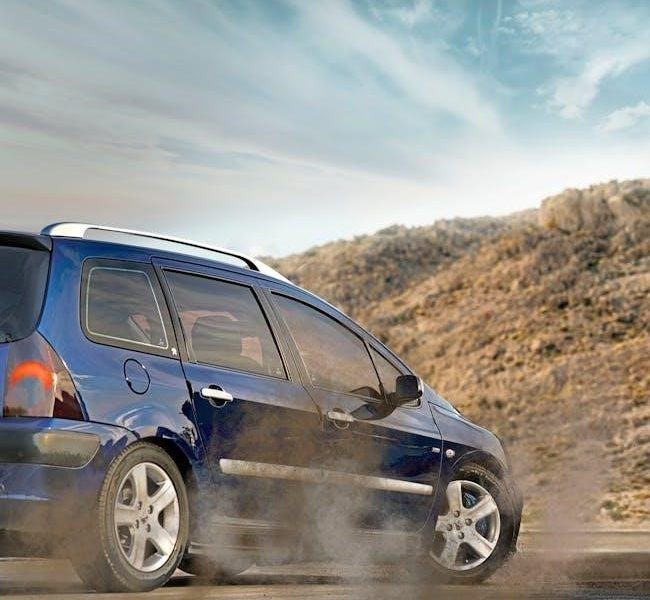
5 speed manual vs 6 speed manual
Manual transmissions offer precise control and driving engagement. The debate between 5-speed and 6-speed manuals revolves around performance, fuel efficiency, and driving comfort. This article explores their differences, helping drivers choose the best option for their needs.
1.1 Importance of Understanding Manual Transmissions
Understanding manual transmissions is crucial for optimizing performance, fuel efficiency, and driving experience. Knowing the differences between 5-speed and 6-speed manuals helps drivers make informed decisions tailored to their specific needs. Whether for city driving, highway cruising, or performance applications, the right transmission choice can significantly impact vehicle behavior and maintenance costs. By grasping the fundamentals of manual transmissions, drivers can better appreciate how gear ratios, shifting characteristics, and mechanical complexity influence their driving habits and overall satisfaction. This knowledge empowers drivers to select the most suitable transmission for their lifestyle and preferences, ensuring a more enjoyable and efficient driving experience.
1.2 Purpose of the Article
This article aims to provide a comprehensive comparison between 5-speed and 6-speed manual transmissions. By examining their gear ratios, performance capabilities, fuel efficiency, and maintenance requirements, drivers can make informed decisions. The purpose is to highlight the advantages and disadvantages of each, helping readers choose the best transmission for their driving habits and vehicle needs. Whether for daily commuting or high-performance applications, this guide offers insights to enhance driving satisfaction and optimize vehicle performance. Understanding these differences ensures drivers select the most suitable option, balancing cost, reliability, and driving experience.
1.3 Overview of 5-Speed and 6-Speed Manuals
A 5-speed manual transmission offers simplicity and durability, often preferred for its straightforward design and lower cost. It features five forward gears, typically suited for city driving and moderate performance needs. In contrast, a 6-speed manual adds an extra gear, usually an overdrive, enhancing fuel efficiency and smoother cruising at higher speeds. Both transmissions require driver engagement but cater to different driving styles. The choice between them depends on factors like driving conditions, desired performance, and budget. This overview sets the stage for a detailed exploration of their unique characteristics and applications.

What Are Manual Transmissions?
A manual transmission is a gearbox requiring driver input to change gears. It uses a clutch and shift lever to engage or disengage gears manually.
2.1 Definition of a Manual Transmission
A manual transmission, also known as a stick shift, is a type of gearbox that requires the driver to manually change gears using a clutch pedal and a shift lever. Unlike automatic transmissions, manual transmissions rely on the driver to engage and disengage the clutch to select different gear ratios, providing control over engine RPM and torque delivery. This system is typically lighter, more fuel-efficient, and offers a more engaging driving experience compared to automatics.
2.2 History of Manual Transmissions
Manual transmissions date back to the early 20th century, evolving from basic 2- and 3-speed systems. Over time, advancements led to 4-speed, 5-speed, and eventually 6-speed designs. These improvements aimed to enhance performance, efficiency, and driver comfort. The introduction of synchronized gears in the mid-20th century revolutionized manual transmissions, making shifting smoother and easier. Modern manuals, like the 5-speed and 6-speed, incorporate lightweight materials and optimized gear ratios, catering to diverse driving needs. This progression reflects the automotive industry’s commitment to innovation and driver satisfaction.
2.3 Key Components of a Manual Transmission
A manual transmission consists of several critical components. Gears, including drive gears and idler gears, are essential for transmitting power. The gearshift connects to the transmission, allowing drivers to select gears. The clutch assembly engages and disengages power from the engine. Bearings and synchros ensure smooth gear transitions. The transmission casing houses all internal parts, while the input and output shafts transfer power to and from the engine and driveshaft. These components work together to provide precise control over speed and torque, enabling efficient power delivery in both 5-speed and 6-speed systems.

Differences Between 5-Speed and 6-Speed Manuals
The primary difference lies in the extra gear ratio, offering improved fuel efficiency and smoother power delivery in 6-speed transmissions compared to 5-speed models.
3.1 Gear Ratios and Their Impact on Performance
Gear ratios significantly influence acceleration and fuel efficiency. 5-speed manuals often feature wider-spaced ratios, optimizing torque for specific driving conditions, while 6-speeds provide closer ratios, enhancing power delivery and reducing engine strain at higher speeds. The additional gear in 6-speed transmissions allows for better distribution of engine RPMs, resulting in smoother acceleration and improved fuel economy, especially during highway driving. This makes 6-speeds more versatile for varied driving scenarios compared to 5-speeds, which may require more frequent shifting to maintain optimal performance.
3.2 Weight and Size Differences
6-speed manual transmissions are generally heavier and slightly larger than 5-speed units due to the additional gear and components. The extra gear set and shafts add weight, though the difference is minimal. The 5-speed is more compact, making it easier to install in smaller vehicles. However, the size difference is often negligible, and modern engineering has minimized these variations. The weight increase in 6-speeds is typically offset by improved performance and fuel efficiency. Both transmissions remain relatively lightweight compared to automatics, ensuring they retain their advantage in terms of driver engagement and efficiency.
3.3 Driver Experience and Shifting Characteristics
The 5-speed manual offers a smoother, more straightforward shifting experience, making it ideal for city driving and everyday use. Its shorter gear lever and simpler mechanism provide effortless transitions. In contrast, the 6-speed manual delivers a sportier feel with more precise, notchy shifts, appealing to driving enthusiasts. The additional gear in the 6-speed allows for better control at higher speeds, enhancing acceleration and performance. However, it may require slightly more skill and practice to master. Both transmissions cater to different driving styles, with the 5-speed being more forgiving and the 6-speed offering a more engaging experience for skilled drivers.
3.4 Mechanical Complexity and Reliability
The 5-speed manual is simpler in design with fewer components, making it more durable and easier to maintain. Its straightforward construction reduces the risk of mechanical failure. The 6-speed manual, while more complex due to the extra gear, still maintains high reliability but requires more precise engineering. Both transmissions are robust, but the 6-speed’s added complexity can lead to higher repair costs if issues arise. Overall, the 5-speed is favored for its simplicity and long-term dependability, while the 6-speed offers advanced performance with minimal compromise in reliability.
3.5 Fuel Efficiency and Cruising Capabilities
The 6-speed manual generally offers better fuel efficiency due to its additional overdrive gear, which lowers engine RPM at highway speeds. This reduction in RPM decreases fuel consumption and enhances cruising comfort. In contrast, the 5-speed manual often operates at higher RPM during highway driving, which can reduce fuel economy and lead to increased engine wear. For long-distance driving, the 6-speed’s extra gear provides a more relaxed and efficient experience. However, the 5-speed remains efficient in city driving or lower-speed scenarios, where frequent gear changes are less impactful on fuel consumption.
3.6 Cost and Maintenance Considerations
The 5-speed manual is typically more cost-effective than the 6-speed, both in purchase price and maintenance. Its simpler design leads to lower repair costs and easier access to replacement parts. In contrast, the 6-speed manual, with its additional gear and complexity, is generally more expensive to purchase and maintain. Over time, the 6-speed may incur higher labor costs due to its intricate components. However, the 6-speed’s advanced features often justify the extra expense for drivers prioritizing performance. For budget-conscious drivers, the 5-speed remains a practical and economical choice.

Advantages of 5-Speed Manual Transmissions
The 5-speed manual offers simplicity, durability, and cost-effectiveness. Its straightforward design makes it easier to maintain and repair, appealing to budget-conscious drivers seeking reliability and lower ownership costs.
4.1 Simplicity and Durability
The 5-speed manual transmission is known for its mechanical simplicity, which contributes to its durability. With fewer components compared to a 6-speed, it is less prone to mechanical failures and requires less complex engineering. This simplicity translates into a more robust and long-lasting transmission, making it a preferred choice for drivers who prioritize reliability. The straightforward design also means it can withstand harsher driving conditions and is less likely to experience issues over time. Additionally, the reduced number of gears results in less wear and tear on internal components, further enhancing its lifespan.
4.2 Better Suitability for certain driving conditions
4.2 Better Suitability for Certain Driving Conditions
The 5-speed manual transmission is often preferred for specific driving scenarios, particularly in city driving where frequent shifting is required. Its shorter gear ratios make it ideal for low-speed maneuvers and navigating traffic. Additionally, the 5-speed is well-suited for engines with higher torque outputs, as it provides better control and responsiveness in such conditions. Drivers who prioritize simplicity and durability in urban environments or for modified engines often favor the 5-speed. Its straightforward design also makes it a popular choice for those who prefer a more direct driving experience without the complexity of additional gears.
4.3 Easier to Maintain and Repair
The 5-speed manual transmission is generally simpler in design compared to the 6-speed, making it easier to maintain and repair. With fewer gears and components, there is less complexity, reducing the likelihood of mechanical issues. This simplicity also translates to lower maintenance costs over time. Additionally, parts for 5-speed transmissions are often more readily available and less expensive than those for 6-speed models. For drivers who prioritize reliability and ease of upkeep, the 5-speed manual is a practical choice, offering a cost-effective solution without compromising on performance.
4.4 Cost-Effectiveness
The 5-speed manual transmission is often more cost-effective than its 6-speed counterpart. With fewer components and a simpler design, the 5-speed typically has a lower purchase price and reduced insurance costs. Maintenance and repair expenses are also generally lower due to the availability of affordable parts and less complex mechanisms. For drivers on a budget or those prioritizing affordability without sacrificing performance, the 5-speed manual offers significant financial advantages. Its cost-effectiveness makes it a popular choice for those seeking a reliable and economical driving experience.

Disadvantages of 5-Speed Manual Transmissions
Limited gear ratios can lead to higher engine RPMs at highway speeds, reducing fuel efficiency and comfort during long drives. Fewer gears also restrict performance flexibility.
5.1 Limited Gearing Options
A 5-speed manual transmission has fewer gear ratios, limiting its adaptability to varying driving conditions. With only five gears, the spacing between ratios is wider, which can result in less precise control over engine RPMs. This makes it less efficient for both city driving and highway cruising compared to a 6-speed. The lack of an additional overdrive gear means higher engine speeds at higher velocities, potentially reducing fuel economy and increasing wear on the engine. This limitation can be particularly noticeable during long-distance trips or when driving in hilly terrain, where more gear options would be beneficial.
5.2 Higher Engine RPM at Highway Speeds
A 5-speed manual transmission often results in higher engine RPM at highway speeds due to the lack of an additional overdrive gear. With fewer gear ratios, the engine must work harder to maintain cruising speeds, leading to increased fuel consumption and engine wear. This is particularly noticeable on long-distance trips, where a 6-speed transmission would offer a more efficient top gear. The higher RPMs can also make the driving experience less comfortable, as the engine may feel strained or noisier at higher velocities. This limitation makes 5-speeds less suitable for highway-driven vehicles compared to their 6-speed counterparts;
5.3 Less Efficient for Long-Distance Cruising
The 5-speed manual transmission is less efficient for long-distance cruising due to its limited gear ratios. Without an additional overdrive gear, the engine operates at higher RPMs, increasing fuel consumption and engine strain. This makes it less suitable for highway driving compared to a 6-speed, which offers a more efficient top gear for cruising. The higher RPMs also lead to increased noise and discomfort during long trips. For drivers prioritizing fuel economy and comfort on extended journeys, a 6-speed transmission is generally a better choice. This limitation underscores the trade-offs of a 5-speed setup.

Advantages of 6-Speed Manual Transmissions
6-speed manuals offer improved fuel economy, reduced engine strain at high speeds, and smoother power delivery. The additional gear enhances cruising comfort and overall driving efficiency.
6.1 Improved Fuel Economy
The 6-speed manual transmission offers enhanced fuel economy due to its additional gear ratio, which allows for lower engine RPM at higher speeds. This reduces engine strain and consumption, particularly during highway driving. The extra gear enables smoother power delivery and better optimization of engine performance across various driving conditions. Drivers can expect improved mileage, especially on long trips, where maintaining consistent speeds is more efficient. This makes the 6-speed transmission a practical choice for those prioritizing fuel efficiency without compromising on performance or driving experience.
6.2 Smoother Power Delivery and Better Acceleration
The 6-speed manual transmission offers smoother power delivery and improved acceleration compared to its 5-speed counterpart. The additional gear ratio allows for tighter spacing between gears, enabling the engine to stay within its optimal RPM range during acceleration. This results in more consistent power output and reduced drops in torque between shifts. The 6-speed transmission also provides better low-end grunt, making it ideal for rapid acceleration from a standstill. Overall, the 6-speed design enhances the driving experience by delivering power more seamlessly and efficiently, especially in performance-oriented driving scenarios.
6.3 Enhanced Driving Experience
The 6-speed manual transmission elevates the driving experience by offering a more refined and engaging feel. With an extra gear, drivers can enjoy smoother transitions between speeds, particularly at higher RPMs. This reduces the abruptness of gear changes, making the ride more comfortable. The tighter gear ratios also allow for better control during acceleration, especially in performance driving. Additionally, the 6-speed transmission often features improved shift mechanisms, resulting in a more precise and satisfying shift action. These enhancements make the 6-speed manual a preferred choice for drivers seeking both performance and comfort.
6.4 Better Overdrive Capability
The 6-speed manual transmission offers superior overdrive capability compared to its 5-speed counterpart. The additional gear allows for lower engine RPMs at highway speeds, reducing wear and tear on the engine. This results in improved fuel efficiency and a quieter, more comfortable cruising experience. The overdrive gear in a 6-speed transmission is particularly beneficial for long-distance driving, as it reduces the strain on the engine and minimizes the need for frequent gear shifts. This feature makes the 6-speed manual a more practical choice for drivers who prioritize efficiency and comfort during extended road trips or highway driving scenarios.

Disadvantages of 6-Speed Manual Transmissions

6-speed manuals are more expensive, heavier, and mechanically complex than 5-speeds. Their added weight and size can reduce fuel efficiency in smaller vehicles, affecting performance.
7.1 Higher Cost
6-speed manual transmissions are generally more expensive to purchase and maintain than their 5-speed counterparts. The additional gear and more complex engineering drive up production costs. This makes 6-speed transmissions less accessible for budget-conscious drivers. Additionally, repair and replacement parts for 6-speeds are often pricier due to their increased mechanical complexity. While the extra gear offers performance benefits, it comes at a financial cost, making 5-speeds a more economical choice for many drivers. This cost difference is a significant factor for those prioritizing affordability and simplicity in their vehicle.
7.2 Increased Mechanical Complexity
6-speed manual transmissions are mechanically more complex than 5-speeds, with an additional gear and synchronizers. This complexity requires more precise manufacturing and assembly, which can lead to higher failure rates if components are not engineered or maintained properly. The added gear also introduces more potential points of wear and tear, such as extra bearings and gear teeth. While modern engineering has improved reliability, 6-speeds still have more parts that could malfunction compared to simpler 5-speed designs. This increased complexity can translate to more challenging repairs and a higher likelihood of mechanical issues over time.
7.3 Heavier and Larger in Size
6-speed manual transmissions are generally heavier and larger than their 5-speed counterparts due to the additional gear and supporting components. The extra gear, bearings, and housing required for the 6-speed design contribute to increased weight and space demands. This added bulk can affect the car’s power-to-weight ratio, particularly in lightweight or performance-oriented vehicles. Additionally, the larger size may limit installation options in vehicles with limited engine bay space. While modern designs aim to minimize these differences, 6-speeds typically remain heavier and more substantial than 5-speed transmissions, which can be a consideration for drivers prioritizing weight distribution or handling characteristics.

Use Cases for 5-Speed vs 6-Speed Manuals
The choice between 5-speed and 6-speed manuals depends on driving conditions, performance needs, and vehicle modifications. Each transmission type excels in specific scenarios, ensuring optimal performance and efficiency.
8.1 City Driving vs Highway Driving
In city driving, a 5-speed manual is often preferred due to its simplicity and fewer gears, making it easier to navigate stop-and-go traffic. The shorter gear ratios provide quick acceleration and better low-speed maneuverability. Conversely, a 6-speed manual excels on highways, offering an additional overdrive gear that reduces engine RPM at high speeds, improving fuel efficiency and reducing noise. The 6-speed’s taller gearing makes cruising more comfortable during long drives. Ultimately, the choice depends on the driver’s primary use case, with 5-speeds suiting urban environments and 6-speeds optimizing highway performance.
8.2 Racing and Performance Applications
In racing and performance applications, the choice between a 5-speed and 6-speed manual transmission depends on specific needs. A 5-speed is often preferred for its simplicity, durability, and lighter weight, making it easier to modify for high-performance engines. The shorter gear ratios in a 5-speed can also be beneficial for quick acceleration in tight racing conditions. However, a 6-speed offers an extra gear, allowing for smoother power delivery and better control at higher RPMs, which can be advantageous in certain racing scenarios. Ultimately, the decision hinges on the balance between weight, complexity, and gear ratio requirements for the specific application.
8.3 Towing and Heavy-Duty Use
For towing and heavy-duty applications, the choice between a 5-speed and 6-speed manual transmission depends on the specific requirements. A 5-speed transmission is often preferred for its simplicity and durability, making it well-suited for heavy-duty use where reliability is critical. The fewer gears mean less complexity, reducing the risk of mechanical failure under stress. On the other hand, a 6-speed transmission offers an additional gear, which can help maintain lower engine RPMs during heavy towing, reducing strain on the engine. However, the added complexity may increase the risk of mechanical issues. Ultimately, the decision should be based on the vehicle’s intended use and the engine’s torque characteristics.
8.4 Engine Modifications and Customization
When considering engine modifications, the choice between a 5-speed and 6-speed manual transmission depends on the desired performance characteristics. A 5-speed transmission is often preferred for its simplicity and durability, making it a popular choice for heavily modified engines where reliability is paramount. The fewer gears allow for more straightforward customization and tuning, especially in high-torque applications. In contrast, a 6-speed transmission offers finer control over engine RPMs, which can be beneficial for engines with specific power bands. However, the added complexity may require more precise adjustments during customization. Ultimately, the transmission choice should align with the engine’s modified capabilities and the driver’s preferences for power delivery and control.

How to Choose the Right Transmission
Assess your driving habits, engine modifications, and maintenance preferences to decide between a 5-speed or 6-speed manual. Consider gear ratios, performance needs, and long-term reliability for the best fit.
9.1 Assessing Your Driving Habits
Evaluate your daily driving conditions to choose the right transmission. If you primarily drive in the city, a 5-speed may suffice due to its simplicity and durability. For frequent highway driving, a 6-speed’s additional overdrive gear reduces engine RPM and improves fuel efficiency. Consider whether you prioritize performance, comfort, or fuel economy. Racing or heavy-duty use may favor the 6-speed’s smoother power delivery and extra gear for better acceleration. Your driving style and the terrain you frequent are critical factors in deciding between these options.
9.2 Considering Rear End Gears and Axle Ratio
The axle ratio and rear end gears significantly impact transmission performance. A higher axle ratio pairs well with a 6-speed manual, allowing better utilization of the additional overdrive gear for optimal fuel efficiency and cruising. Conversely, a lower axle ratio may benefit a 5-speed, providing more responsive acceleration in city driving. Balancing these components ensures the engine operates within its optimal RPM range, enhancing both performance and efficiency. Consulting with experts or using specialized tools can help determine the ideal setup for your vehicle and driving needs.
9.3 Shifting Preferences and Driver Skill Level
Driver skill and shifting preferences play a crucial role in choosing between 5-speed and 6-speed manuals. Experienced drivers often prefer the precision and control of a 6-speed, which offers smoother shifting and better modulation. However, less experienced drivers may find the 5-speed easier to manage, as it requires less frequent shifting and is more forgiving. The 6-speed’s additional gear can be challenging for new drivers, while the 5-speed’s simplicity makes it ideal for casual driving. Ultimately, the choice depends on the driver’s comfort with shifting frequency and their ability to handle the added complexity of an extra gear.
9.4 Budget and Maintenance Costs
Budget and maintenance costs are essential considerations when choosing between 5-speed and 6-speed manuals. Generally, 5-speed transmissions are more affordable upfront and require less maintenance due to their simplicity. Parts for 5-speeds are often cheaper and more readily available, making repairs less costly. In contrast, 6-speed transmissions are typically more expensive to purchase and maintain, with higher costs for replacement parts and labor. However, 6-speeds may offer better fuel efficiency, potentially offsetting long-term expenses. Drivers on a tight budget or prioritizing simplicity often favor the 5-speed, while those willing to invest in advanced performance might prefer the 6-speed.
10.1 Summary of Key Differences
The primary distinction between 5-speed and 6-speed manuals lies in gear ratios and performance capabilities. A 6-speed transmission offers an additional gear, typically an overdrive, enhancing fuel efficiency and reducing engine RPM at higher speeds. This makes it ideal for highway driving and long-distance cruising. Conversely, the 5-speed is simpler, lighter, and often preferred for city driving or modified engines due to its durability. Driver preference also plays a role, as some favor the notchier feel of a 6-speed, while others appreciate the straightforward nature of a 5-speed. Both transmissions cater to different driving styles and priorities.
10.2 Final Recommendations
Choose a 5-speed manual for simplicity, durability, and lighter weight, ideal for city driving or modified engines. Opt for a 6-speed if prioritizing fuel efficiency, smoother power delivery, and highway comfort. Consider driving habits, budget, and vehicle use case. For racing or performance, the 6-speed’s additional gear and overdrive capability are advantageous. Conversely, the 5-speed’s straightforward design suits casual or urban driving. Assess personal preferences and needs to select the transmission that best aligns with your lifestyle and driving goals for an optimal ownership experience.
Archives
Calendar
| M | T | W | T | F | S | S |
|---|---|---|---|---|---|---|
| 1 | 2 | |||||
| 3 | 4 | 5 | 6 | 7 | 8 | 9 |
| 10 | 11 | 12 | 13 | 14 | 15 | 16 |
| 17 | 18 | 19 | 20 | 21 | 22 | 23 |
| 24 | 25 | 26 | 27 | 28 | 29 | 30 |
Leave a Reply
You must be logged in to post a comment.